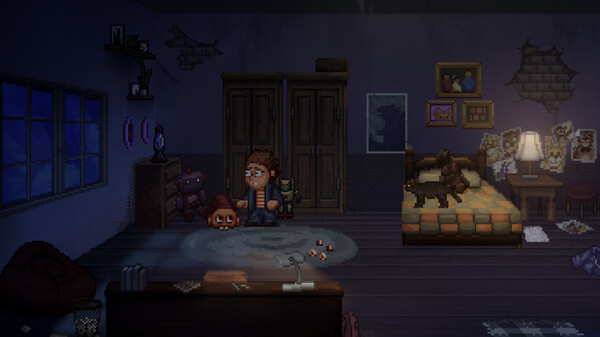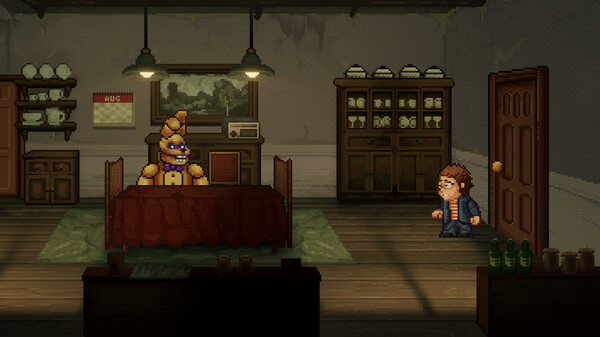Into the (Money) Pit: Economic Horror at Freddy's
Samantha Trzinski, Contributing Editor
The latest installment in the Five Nights at Freddy’s franchise diverts from the style and plotline of previous games. The player does not watch for animatronics on security cameras as they did in early installments of the franchise, nor do they attempt to escape a pizzeria after closing with the help of an animatronic friend as they did in Security Breach. In Into the Pit, the player assumes the role of Oswald, a child who accidentally travels through time when he jumps into an abandoned ball pit in the back of a local pizzeria. When he goes “into the pit,” Oswald is transported to the 1980s, when the local pizzeria was a Freddy’s Pizza, home to animatronic animals and some dark secret, only hinted at by people in Oswald’s day.
When he first travels to Freddy’s Pizza, everything seems perfect. The restaurant is booming, jam-packed with patrons who are eating, playing arcade games, and enjoying the animatronic show. Shortly after Oswald first travels through time, though, something horrible happens at Freddy’s Pizza. Suddenly, the lights go out. Children scream. Then, Oswald sees it – a golden animatronic rabbit who is terrorizing the patrons of the pizzeria. Here, the game assumes a typical plotline for a Five Nights at Freddy’s installment as the player must avoid death at the hands – or the paws – of animatronics. However, the most terrifying thing about Into the Pit is not the fear of death or the risk of bodily harm, but rather the economic collapse that is occurring in the game’s background.
Into the Pit emphasizes a growing economic uncertainty in the United States. The town in which Oswald lives was once a bustling industrial center. At its heart was the Mill, where countless residents were employed from the 1980s until just a few years prior to the game’s beginning. The player learns from Oswald’s expository interactions with his father in the game’s opening scene that the Mill was where he once worked – until it closed, in the modern day, three years previously. Now, Oswald’s father works part-time at the local Corner Store, and he hopes to work more hours there, soon. However, Oswald painfully reminds his father that the Corner Store will probably close soon, too. When Oswald’s father insists that the family’s finances will get better once he can work full-time, Oswald replies, “If the Corner Store even survives that long. Everything in this town is dead or dying, and there’s no telling what’s closing next.” Oswald asks his father why they do not move to the next town over, as most of his friends’ families have done since the Mill closed. His father tells him it is not possible for them to move, as Oswald’s grandmother wants to stay in the town.
The introductory scene to the game is heavy with expository information, but it effectively lays the foundation for 1980s economic nostalgia and orients the player as Oswald arrives at Jeff’s Pizza, the “only pizza” in town (according to advertising from the restaurant itself) and “all we can afford” (according to Oswald’s father). Jeff’s Pizza, now a locally-owned pizza joint, was once a popular location of Freddy’s Pizza, a pizzeria and arcade known for its state-of-the-art animatronic mascots who performed for customers. Jeff’s Pizza is nowhere near as impressive and technologically advanced as its predecessor. As Oswald learns from another customer, the pizza at Jeff’s does not taste nearly as good as the pizza from Freddy’s once did; however, it is much cheaper. The specials board located at the front of the restaurant asserts how inexpensive Jeff’s pizza is; for $1.50, a customer can get a slice of pizza and a soda.
Despite being the “only pizza” in town and having relatively low prices, Jeff’s Pizza typically is not busy. There may be another customer or perhaps a family at the restaurant at the same time as Oswald, but there are rarely any more people present. The restaurant is dilapidated and unclean, a clear sign of its barely scraping by, fiscally speaking. The only rooms of the building that are still regularly used are its lobby, dining room, and kitchen. The other rooms are filled with trash, grime, and paraphernalia from Freddy’s Pizza, haunting Jeff’s Pizza as a reminder of the past. With so few patrons, though, Jeff does not need to maintain the entire building. He keeps the few necessary rooms in a presentable condition and largely ignores the other rooms or uses them only for storage.
After his time-traveling ball pit experience, Oswald emerges in a room filled with kids chatting, playing, and eating pizza. The room is clean, the lights are bright, and music is blasting through the speakers. He speaks to some of the kids who are in the room, and they are surprised to learn that Oswald does not know about Freddy’s Pizza or its animatronic mascots. They brush off Oswald’s ignorance for his being new to town: “The mill is bringing in a lot of newbies like you into town,” they tell him. This encounter is the first clue for Oswald that something is not quite right when he emerges from the ball pit. As he explores the pizzeria, he finds other clues that reveal to him the time-travel mystery he is facing. He overhears two children talking about a movie that they are going to see later. Although the child cannot remember what the movie’s title is, he says that it has “something about people busting ghosts”; obviously referencing the 1984 film Ghostbusters. Oswald encounters another child who is wearing a “Future of the Flashback” shirt, a reference to Back to the Future, which released in 1985. Oswald tells him that it is his “favorite old movie,” to which the child responds with confusion. According to him, the movie was only released three weeks prior. If these pieces of dialogue are not quite clear enough, a calendar in one of the back rooms reveals that it is June 1985.
One of the things that Oswald finds astonishing about the 1980s is the price of candy. When the player interacts with the candy dispensers at Freddy’s Pizza, Oswald remarks, “25 cents for candy? I could eat candy for the rest of my life!” The game also encourages the player to indulge in Oswald’s candy mania and excitement over its low price. The player receives an achievement after interacting with the candy dispensers ten times and unlocks a secret mini game if they continue interacting with the dispensers.
While Oswald is fascinated by the economic success and low prices of the 1980s, we see that his town in the modern day is facing a fast-approaching economic collapse. In typical Five Nights at Freddy’s fashion, the game takes place over the course of five days. After the initial events at Freddy’s Pizza, Oswald jumps back into the ball pit to return to the current day. However, the animatronic rabbit follows him and kidnaps his father. Each night, Oswald escapes his house and journeys to Jeff’s Pizza, where he jumps back into the pit to try to find where his father has been taken. With each night, though, Oswald’s house becomes increasingly more dilapidated. The town itself is wildly decaying, too; a once thriving town is now left in ruin as corporations prioritized capital gain over workers’ needs.
Throughout the game, Oswald can visit the school, library, and Mill, in addition to his house and Jeff’s Pizza. The mill, now abandoned, has become symbolic of the post-Reagan economic collapse and is used by the town’s remaining residents as a dump. Jeff even asks Oswald at one point to take a bag of garbage to the mill because he does not pay for a dumpster service (or for employees). The school has only one active classroom, with the other rooms in the school being empty or devoid of people. Half of the lockers at the school are unused because there are not enough students, and posters on the wall are torn, faded, and grimy. It is evident as the player explores this town that it is in ruin and is quickly falling apart. With so few residents, the town is limping along, economically speaking.
Into the Pit’s ending further accentuates the game’s focus on economic ruin and how it is impacting the community in which Oswald lives. The game features various endings, dependent on what the player does throughout the course of the game. In the “good” ending, Oswald rescues his father, defeats the golden rabbit animatronic, and returns home with the promise that the family will move to another town. The game then shows a brief cutscene with Oswald and his parents at Jeff’s Pizza, which is packed with patron and features a smiling Jeff, serving pizza to the masses. This ending asserts the importance of the town’s economy to the game. In the game’s best ending, Oswald’s family promises to move to another town that is not facing the same economic ruin that their current town is, and Jeff’s Pizza transforms from a shell of its preceding pizzeria to one filled with paying customers. This ending links together Oswald’s happiness and success with economic growth. However, the various endings also make clear to the player that the economic prosperity of the 1980s is an unobtainable dream; there is no ending where the town is once again the thriving community it was in 1985. That possibility has, quite literally, been killed.
Like most Five Nights at Freddy’s games, Into the Pit centers around the animatronics at Freddy’s Pizza and a horrible series of murders that take place at the pizzeria. A small town’s economic collapse is, perhaps, not intended to be the defining feature of this game. However, a consideration of it adds an additional layer of meaning to the game. It shows the anxiety and fear that is placed onto Oswald as his parents deal with their financial situation as their town falls into disarray. Oswald, as a child, is not responsible for his family’s finances, but he is aware of what is happening. He can see the town becoming a shell of its former self, and he sees the immense stress placed onto his parents as they struggle to make ends meet. Into the Pit emphasizes the impact that economic uncertainty has on all members of a community and reveals the stress that such uncertainty places onto a particular family. It also suggests that the nostalgia for the Reagan era economic boom may be misguided, and that the 1980s may not be all that they have been idealized to be.
Published 9/26/24.




